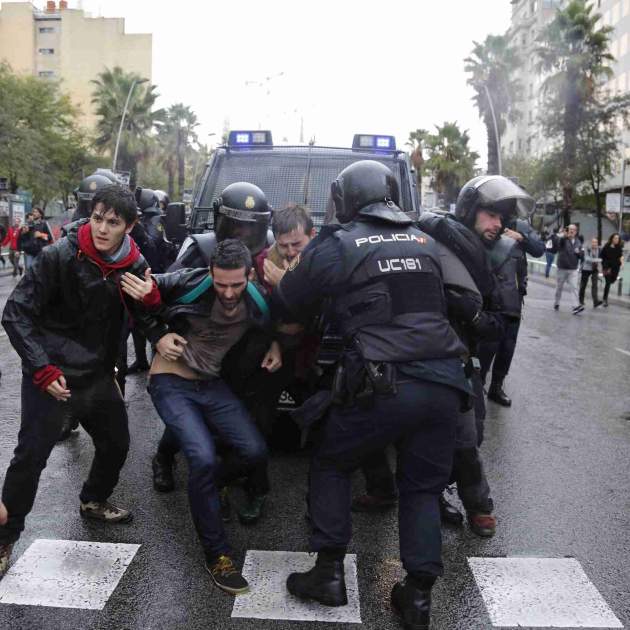Extreme and indiscriminate violence against peaceful citizens waiting to vote in Catalonia's referendum. This is the response that the Spanish state has unleashed, orchestrating police attacks carried out by a touring convoy of van-loads of riot police from Spain's National Police force, which are striking against polling stations one after another.
The attacks are not improvised. Sant Julià de Ramis, where Catalan President Carles Puigdemont had to vote, was one of the first voting centres to be visited by riot forces. The Catalan Ministry of Education, where minister Clara Ponsati was dragged across the ground; the Infant Jesus school in Barcelona, where the first images of bloodied wounds appeared - a woman with a head injury and a man who had to be moved by ambulance; the city of Sabadell with police charges in the middle of the street and rubber bullets fired; Sant Carles de la Ràpita, where the injured number in the dozens ... And from there, the attacks have been repeated with dozens of National Police vans moving as a group from centre to centre.
At the polling stations, they had just finished assembling the tables and setting up the ballot boxes. Dozens of local residents has kept watch over the centres during the night to prevent them from being sealed off by police, and from five in the morning hundreds of people began gathering at the gates. From 6am on, the Catalan police force, the Mossos, arrived at all the centres, but faced by large crowds they did no more than make the gesture of an appearance. In many cases, a Catalan police car remained on watch.
The Spanish police forces, however, did not hesitate to expedite matters. Riot squads entered schools by baton blows, breaking glass and jumping fences, and removed both the boxes and the ballots to prevent voting.
The alarms began to ring with the harassment of voters at the Barcelona secondary school Institut Ramon Llull, even before polls opened at 9am. Ballot boxes were taken away after a police charge against the people trying to block the entrance. The next target was the Institut Balmes high school. The convoy of vans has carried on moving through the streets of Barcelona and those of other Catalan towns and cities.
In some schools, those in charge of the electoral tables hid the election material. There are reports of police brutality, by police officers who pressured those present to reveal where the ballot boxes were.
It was precisely in anticipation of this possible situation that the Catalan government announced, before the opening of the polls, that it had created a universal census so that any voter would be able to vote at any of the polling stations. After eleven o'clock in the morning, however, the Civil Guard announced that it had neutralized this universal census.
Voting amidst a tsunami of violence
President Puigdemont has responded to the police operation with a declaration expressing his indignation in the face of the "insane wave of unjustified violence" against peaceful citizens, and has called people to respond throughout the day by going to the polls to vote.
Translation: Violence will not stop the desire of Catalans to vote. Today it is clear in the eyes of the world what is at stake for us. - Catalan Government
At midday, the Government published a map showing the polling stations open and those that have been closed so that Catalans can consult where they can go to vote.
By early afternoon, the Catalan Government still maintained three-quarters of all polling stations open, with a total of 4,561 voting tables operating.
